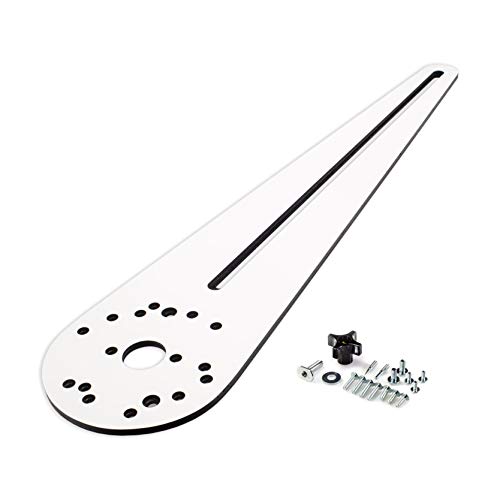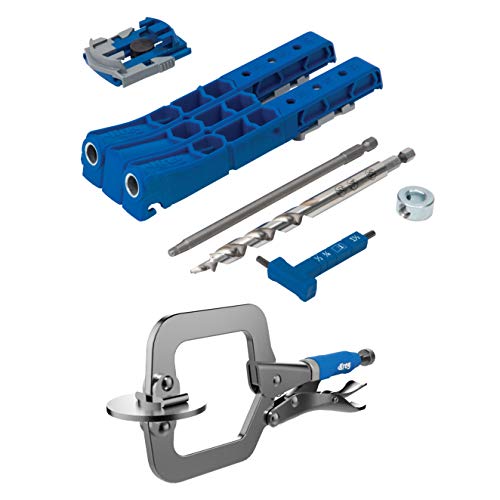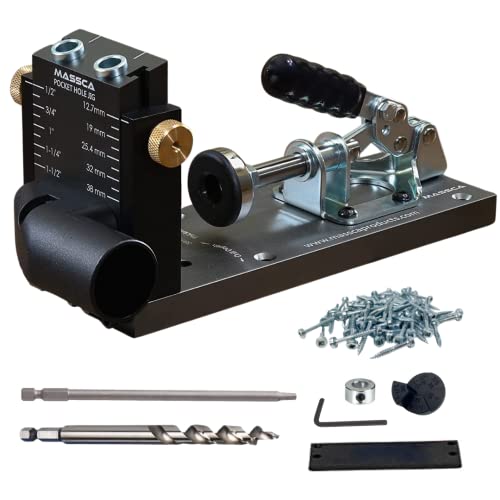The Best Plywood Jigs for Safer Woodworking

Our Top Picks
- Best Overall: POWERTEC Router Circle Jig Shop Now ➔
- Runner Up: Kreg Pocket Hole Jig Shop Now ➔
- Honorable Mention: Massca Aluminum Pocket Hole Jig Shop Now ➔
What Is the Best Plywood Jig In 2024?
Best Overall
With this increased efficiency router circle cutting jig, you can rout flawlessly made circles with diameters ranging from 10″ to 53″. It’s perfect for making tables, clocks, round frames and signs, cartwheels, and whatever other round project your heart desires and your mind can come up with.
This Router Hole Cutting Jig features predrilled hole patterns for simple installation onto the majority of contemporary routers. If the hole design does not match your model, you may easily adjust it by drilling the appropriate holes. It’s lighter than similar jigs, making it more pleasant to use. For sturdiness, steadiness, and lightweight high-performance, this circular Router Jig is made of melamine-coated 7-layer plywood.
Pros
- Powertec router is easy to install and perfect for circles
- This circular router has a rugged and sturdy construction
- Powertec router has pre-drilled premium router plate
Cons
- This router jig is extremely flimsy
Runner Up
Either you’re creating your first DIY project or have been working with wood for years, the Kreg Pocket-Hole Jig 320 makes it easier than ever to build wood projects. The Pocket-Hole Jig 320 has a quick, straightforward set up method that offers you the flexibility you need to work with boards and plywood with thicknesses ranging from 1/2″ to 1.5″.
Two drill guides, a detachable spacer, and material-thickness stops are included with the 320. Assembly is straightforward thanks to the included material thickness gauge and easy-set drill bit, and the handy clamp adapter and anti-slip base keep the jig in place while drilling properly positioned pocket holes every time.
Pros
- It is designed to work in tight spaces
- It has an ergonomic padded grip for comfort and ease
- The gauge quickly and easily finds the thickness of your stock pieces
Cons
- This jig requires a clamp to use
Honorable Mention
The Massca Pocket Hole Jig System is a well-balanced full-body aluminum frame that provides a stable support platform for woodworking in shops or garages. Their aluminum construction assures a strong and heavy-duty pocket hole jig that will last a lifetime while still looking elegant. For extra non-slip protection, you may even screw it in place. The Massca Pocket Hole Jig System includes a heavy-duty clamp that holds your board or piece of wood securely against the jig punch, ensuring a smooth, clean press and preventing splitting. This multi-purpose pocket hole jig may be used for everything from do-it-yourself woodworking tasks in your garage to on-site carpentry and woodworker repairs and custom builds.
Pros
- It has a built-in dust collector which helps in reducing work on the job
- When it’s time to add the screws, it provides flawless integration
- The detachable jig system provides you additional flexibility in your woodworking and crafts
Cons
- The drill can break after a few uses
Best Plywood Jigs Buying Guide
When it comes to cutting a worktop, hardwood flooring, or relatively soft metals like aluminum or plastic, choosing the appropriate jigsaw blades is critical. From hardwood to metal blades, here are our suggestions for a wonderful clean cut!
What Qualities Should You Seek in the Finest Plywood Jig?
Denture
The cutting edge, which is its most important feature, is always represented in teeth per centimeter or inch (one inch = 2.54 cm). Heavy, medium, or fine teeth, inclined or straight, are all possibilities. On the plurality of blades, the teeth are polished in a triangle facing upwards.
Material
The blades can be composed of a variety of materials. When cutting wood, MDF, or plastic, use blades made of high-carbon steel (HCS). This softer, less costly steel offers more flexibility than harder steel, making it ideal for scroll cutting. Bimetal (BIM) blades are used for cutting laminates, wood, and metal. These blades blend HCS flexibility with HSS durability, making them less prone to shatter. They will generally outlive both HCS and HSS blades, despite being more expensive.
Blades made of high-speed steel (HSS) are particularly good at cutting nonferrous metals and acrylics. Although they have a more lasting cutting edge than HCS blades, the added stiffness might result in more blade breakage. Use a blade with tungsten-carbide sharpened teeth for particularly difficult operations, including cutting through embedded nails or metal. Glass, concrete board, brick, and tile are cut with toothless blades with tungsten-carbide grit on the edge.
What Are the Kinds of Jig Blades Available in the Market?
Your jigsaw includes a quick-fix mechanism dedicated to accepting suitable blades, depending on its brand and kind. Attaching these blades to current electric machines is frequently done without the need for tools. Jigsaw blades are divided into two categories: U-shanks and T-shanks (also known as SDS).
U shank blades
Although U-shanks are frequently referred to as “universal” shanks, they are an older shank design that isn’t as popular as it once was. The emergence of the t-shank style and its rapidly shifting pace contributed to the fall in popularity. Most u-shank jigsaw blades require an Allen key and holding screw to be secured into position, which slows down the blade replacement procedure.
T shank blades
Many jigsaws that accept u-shank blades also accept t-shank blades, making the t-shank type the most common and widely utilized of the three. T-shanks were created for quicker blade changing systems, and replacing the t-shank blade on contemporary jigsaws is as simple as pressing a button.
Which Blade Is Appropriate for Which Material?
The most common blades have teeth that face upwards, which means they cut upwards. The sawdust chips are expelled from the top and may thus be collected using a vacuum cleaner attached to the jigsaw’s rear sleeve, which is particularly intended for this purpose. This also implies that the incision will be thicker at the surface’s top. If feasible, trace the cut on the reverse side of the paper (less accuracy) or use an adhesive to make the cut. There are other blades with downwardly toothed teeth and blades with double teeth. Their usage needs some coaching.
Blade made of wood and laminated
Toothed, square or straight, milled or ground, in different lengths up to 150 mm: these are the most frequent and most versatile blades made of this material. The greater the flow rate, the greater the tooth pitch (number of teeth each centimeter or inches). Fitting (two-sided teeth offset) is a key component in yield, although it generates a lot of sawdust. The broad blades are used for rectilinear cuts, such as in joinery, cutting a work plan, and so on. A specific blade is offered if the task involves cutting curves and circles. Because of its thin shape and forward-facing teeth, you’ll easily spot it.
Blades made of plastic and PVC
PVC blades are set or straight medium-toothed blades and they come in a variety of lengths. The length of the cut should be specified and is usually proportional to the blade length.
Steel and non-ferrous metal blades
Fine-toothed blades should be reserved for the hardest metals if you have them in your assortment. Since cutting aluminum, copper, and brass will not be a problem although cutting steel requires a little more thought. It is possible to cut steel with a blade thickness of 1 to 8 mm. When using the finest toothing, use a low speed and be sure to use a cutting lubricant made specifically for this metal, or the blade may become hot and carbonized. With the right lubricant, stainless steel can also be sawed.
Ceramic and glass blades
We prefer blades without teeth in these situations. The front face is coated with a tungsten carbide coating that can easily penetrate tiles and ceramics. It’s a good idea to put a little water near to the incision. The procedure is more delicate with glass, but if you have no other choice, special glass cutting oil is available, albeit a test run is recommended beforehand.
DIY Jig
If you’re interested in building your own jig, this video from TimCam The Jig Man will be very helpful:

People Also Asked
How can you cut plywood without splintering with a jigsaw?
To limit splintering, a narrow blade with upward teeth should work well in plywood cutting. Remember that the jigsaw can handle a variety of blades. If you want a splinter-free surface, you should use the right kind of blades for the job.
Which is quicker at cutting: a blade with a lot of little teeth or a blade with a few huge teeth?
Saw blades with fewer teeth will cut quicker and more aggressively, but will leave a coarser finish in general.
What factors should I consider while purchasing a jigsaw blade?
When cutting wood, use a blade with a TPI of 6 to 10. Sawdust is easier to remove when gullets (the low regions between teeth) are wider. When cutting metal or plastic sheets, a greater tooth count and a slower cut speed are required. A six-TPI blade cuts quicker and tracks straighter in thicker material than a ten-TPI blade, but it creates more chip-out.
Article Contributors
The Woodsmith Review Team’s product reviews and in-depth guides are here to help you choose the best tools and gear to build great-looking projects confidently. Woodsmith is reader-supported: When you buy through links on our site, we may earn an affiliate commission. Large language models (like Artificial Intelligence) may have been used in the research and creation of the content.
Inquiries regarding specific articles or product testing should be sent to aimperiapt@gmail.com



